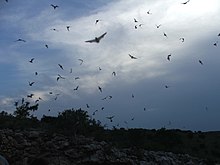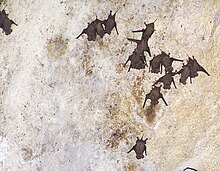Mexican free-tailed bat
Its proclivity towards roosting in huge numbers at relatively few locations makes it vulnerable to habitat destruction in spite of its abundance.[7] Mexican free-tailed bats are typically 9 cm (3.5 in) in length and weigh around 7–12 g (0.25–0.42 oz) with females tending to be slightly heavier than males by 1–2 grams for increased fat storage to use during gestation and nursing.[8] Their tails are almost half their total length and stretch beyond the uropatagium, giving them the name "free-tailed" bats.[8] The wings are elongated and narrow with pointed tips, making them well-equipped for quick, straight flight patterns.[8] The bats can make roosting sites of buildings regardless of "age, height, architecture, construction materials, occupancy by humans and compass orientation".Caves in Florida tend to have pools of water on the floor and the free-tailed bats do not need as much relative humidity as the southeastern myotis.[8] Some bat populations in other areas of North America do not migrate, but are residents and may make seasonal changes in roost sites.[14] Bats ranging eastward from East Texas do not migrate, but local shifts in roost usage often occur seasonally.[15] Large numbers of Mexican free-tailed bats fly hundreds of meters above the ground in Texas to feed on migrating insects.The chemical nonanal is found in such a concentration that its antimicrobial activity can inhibit the growth of two fungal pathogens that cause ringworm (Trichophyton mentagrophytes and T. rubrum), as well as Malassezia furfur, a yeast.Two other common skin disease-causing microbes that are inhibited by the hair's concentration of nonanal include Staphylococcus aureus and Cutibacterium acnes.T. brasiliensis bats are thought to swarm in spiraling motions within caves to ventilate ammonia and renew the air.[29] On 6 November 2014, Aaron Corcoran, a biologist at Wake Forest University, North Carolina, reported online in Science that his team and he had detected Mexican free-tailed bats emitting ultrasonic vocalizations that had the effect of jamming the echolocation calls of a rival bat species hunting moths.The 'jamming' call led to an increased chance of the rival missing its prey, which the Mexican free-tailed bat was then able to eat itself.For instance, during the spring and summer, one of the largest Mexican free-tailed bat populations inhabits Cueva de la Boca, a cave near Monterrey, Mexico.Because of a reduction by more than 95% of the original 20 million bat population to 600,000, as a result of vandalism, pollution, and uncontrolled tourism, the organization decided to buy the property to place it under conservation.BCI planned to revert any land changes that were a result of farming or ranching in order to conserve the biodiversity and wildlife there.Preserving the land around Bracken Cave was important, as it is home to the world's largest bat colony, and any human encroachment would be detrimental to their population.In 1863, a gun powder factory opened near San Antonio, the saltpeter of which was provided by local guano mines.




Conservation statusLeast ConcernIUCN 3.1Scientific classificationEukaryotaAnimaliaChordataMammaliaChiropteraMolossidaeTadaridaBinomial nameI. GeoffroyCentralSouth AmericaCaribbeanuropatagiumground speedsmammalsNorth Americahabitat destructionjust one bridge in AustinTexas LegislaturedescribedIsidore Geoffroy Saint-HilaireholotypeBrazilsister speciesSauromys petrophilusSouth AfricaTadarida aegyptiacaecholocationphotoluminescentultravioletU.S. Fish and Wildlife ServiceArgentinaBracken CaveSan Antoniosoutheastern myotisCarlsbad CavernsCarlsbad Caverns National ParkBaja CaliforniaSierra Madre Orientalbeetlesdragonfliestrue bugsred-tailed hawkAmerican kestrelsgreat horned owlsbarn owlsMississippi kitesVirginia opossumsstriped skunksraccoonseastern coachwhipsWhite-nose syndromePseudogymnoascus destructanslittle brown batnonanalTrichophyton mentagrophytesT. rubrumMalassezia furfurStaphylococcus aureusCutibacterium acnesground speedlocal gustsWake Forest UniversityScienceestrusMonterreyPronatura NoresteBat Conservation InternationalAustin, TexasMexicoCongress Avenue BridgeTexas State CapitolHoustonBuffalo BayouBat bombBrown long-eared batIUCN Red List of Threatened SpeciesWayback MachineDesert MuseumBibcodeWikispeciesIntegrated Taxonomic Information SystemTexas Archive of the Moving ImageWikidataARKiveiNaturalistNatureServeOpen Tree of LifePaleobiology Database